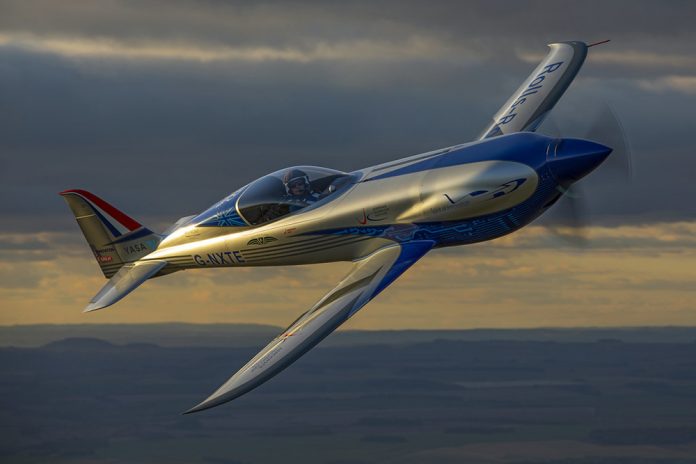Stjohn Youngman, Managing Director of Electroflight, tells Green Business Journal how a landmark air speed record brings us one step closer to aviation electrification.
In January 2022, something incredible happened in the world of aviation. The Spirit of Innovation, an all-electric plane created as part of a ground-breaking programme to push flight electrification to its very limits, was officially recognised as the world’s fastest electric vehicle. It reached speeds of 387.4mph during test flights in November 2021, setting three new world records and validating years of work to prove the viability of all-electric powered flight.
We may well look back in years to come and see this as one of the most significant moments in recent aerospace history. With the global aviation industry producing around 2.1% of all human-induced carbon dioxide emissions, electric-powered flight has garnered increasing interest – yet being able to realise this potential in commercial aviation has remained firmly out of reach. Today we remain limited by the energy density of battery cells against the large energy requirements of flights in even the most modest light aircraft, while the stringent safety and compliance requirements for commercial flight also prove extremely challenging for a method of propulsion that has thus far been largely untested.
The ACCEL project – a partnership between Rolls-Royce, YASA and my company Electroflight, match-funded by the Aerospace Technology Institute – was designed to take a significant step towards tackling some of these fundamental challenges. The Spirit of Innovation proved that we can create battery technologies that meet these stringent requirements, even if only laying the groundwork for further development of the technology for future commercial use in hybrid electric applications and eVTOL (electric vertical take-off and landing).
Pushing the boundaries
Our team at Electroflight spent the last two years designing the full propulsion system and integrated battery system. We have some of the best electrification engineers from across various sectors, including from Formula E and various electric and hybrid supercar programmes, but this project has still pushed us to the very limit.
A battery powered plane requires the correct ratio between power, energy, and weight. While lithium-ion batteries have increased the range of road vehicles to 400+ miles, it remains technically challenging to deliver the required energy storage system to power a take-off and reach record breaking speeds.
The decision was taken to use three axial-flux electric motors capable of 200kW of peak power and a speed range of 0 to 3,250rpm. This high torque but lightweight motor is able to deliver a significant amount of power while keeping the weight ratio to an absolute minimum. We then used 6,480 lithium-ion cylindrical battery cells which were ultrasonically wire bonded to make the connections. There were three isolated redundant battery channels within the system – each sealed from each other and completely independent to ensure that two channels would remain operation in-flight if one failed.
The battery case was also an extremely challenging piece of engineering, as the entire powertrain is connected to the front of the aircraft. The battery case is therefore doing an important job, not just providing containment in the case of a battery fire, but also keeping the front of the aircraft connected to the fuselage structure.
Crucial collaboration
Key to success were the partnerships that were formed with other expert companies in the industry – many of whom worked with us to create innovations that have never been seen before in the aviation sector. The composite structural battery case had to be fire resistant, so Electroflight worked with Amorim Cork Composites to develop a fire-proofed laminate for the battery case internals made from cork lining – a unique application that is now patented.
There had been concerns over managing thermal runaway of the battery packs. In response, the team developed its own battery management system, supported by McLaren Applied, which monitored each cell during flight to detect any anomalies in temperature and build a strong safety case for flight.
Without these partnerships, as well as the investment and overall leadership of Rolls-Royce and the funding from the ATI, the project would never have been successful.
Powering the future
The technological advancements pioneered during ACCEL represent a key milestone in the journey to ‘jet zero.’ However, we will need a significant and sustained influx of investment in battery technology to deliver commercially viable hybrid electric and eVTOL solutions to customers.
The industry should remain pragmatic on how far cell energy density will progress in the coming years and focus efforts where the benefits of battery systems can be fully leveraged to create compelling solutions, such as in hybrid-electric where battery power and motors can be combined with the long-haul duration of gas turbine or ICE propulsion (internal combustion engine). The high bursts of power that can be delivered by battery technologies are ideal for ‘take-off’ and climb phases, allowing combustion elements to be optimised for cruise phase operation, delivering emissions and fuel burn savings.
More achievable for solely electric-powered aircraft are shorter sub-regional routes and intercity travel. Several aerospace start-ups are already exploring the viability of air-taxis, which could bring myriad benefits from removing strain from over-congested road systems to reinvigorating small regional airports.
What is clear is that a move to replacement power sources is becoming ever more urgent in the wake of regulations around carbon emissions and noise pollution, the rising cost of fuel, and efficiency concerns. The Spirit of Innovation took a big step towards proving the viability of electric flight. We now need to build on this ground-breaking achievement by doubling down on investment in battery technologies and bringing forward new innovations that will help unlock the future of electrified aviation.




